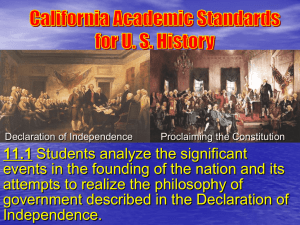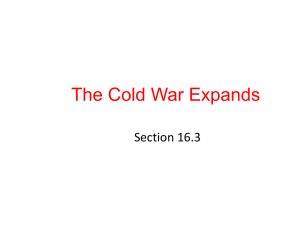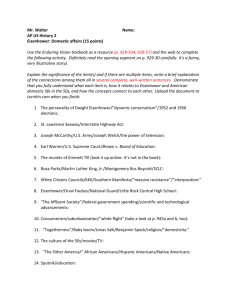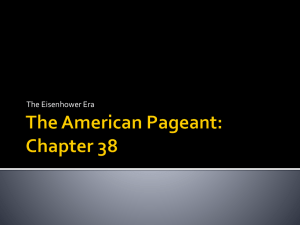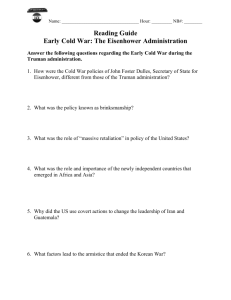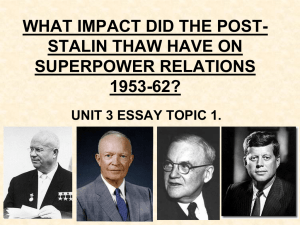Foreign Policy
advertisement
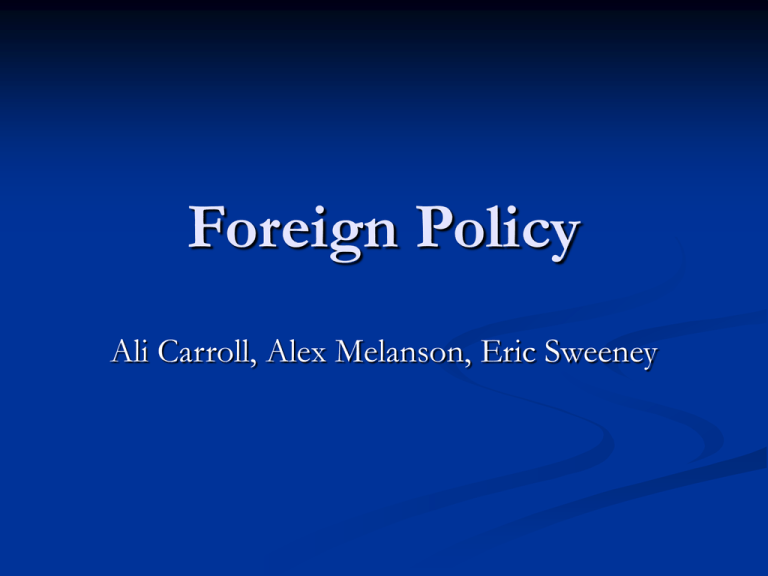
Foreign Policy Ali Carroll, Alex Melanson, Eric Sweeney The Great White Fleet: The American Navy’s World Cruise Strengthening the Navy From the beginning of his presidency, Roosevelt articulated the country’s responsibility in foreign affairs First Annual Message (1901): “Whether we desire it or not, we must henceforth recognize that we have international duties, … American people must either build and maintain an adequate navy or else make up their minds definitely to accept a secondary position in international affairs.” Strengthening the Navy Roosevelt fought legislative resistance from congress as he wanted to build the navy during a time of peace Roosevelt believed a stronger navy was needed: To protect America’s economic livelihood To project America’s technological and martial prowess abroad To establish America as an advanced peacekeeping force abroad Strengthening the Navy To counter legislative resistance, Roosevelt staged a huge media event – announcing in the summer of 1907 that he would send 16 American battleships out in December 1907 to tour the world Foreign Policy and the Rhetorical Challenge Presidents face the rhetorical challenge of dealing with foreign policy during times of peace How does a president call for standard improvements in military capabilities without creating images of war in public’s consciousness? How does a president promote improvement of military capabilities during a time of peace? Roosevelt engaged the media to mythologize the world cruise, in order to conceal the martial nature of the battleship fleet The Media and the Myth Roosevelt provided the media with three traditional themes: A world demanding that America uphold its international responsibility The navy seamen who represented the type of American to fulfill that responsibility The battleship fleet represented the culmination of American ingenuity and determination The World in Need of a Savior The media’s (and Roosevelt’s) constructed universe featured a world comprised of simple cultures that respected American power Focused on the nation’s supposed moral and martial duty as a responsible member of the global community, without addressing the issue of whether world peace was being threatened and needed America to play a great part Declared that America had no enemies in the present universe The Navy Hero Rather than focusing on the traditional picture of a warrior, the press exhibited the sailors’ more benign, heroic traits – Willingness to work Superhuman endurance Civility Roosevelt declared that “sea-man of our warships… are unsurpassed in daring, in resolution, in readiness, in thorough knowledge of their profession” (Second Annual Message, 1902). The Navy Hero “Fighting Bob” – a symbolic hero comprised of characteristics from Rear Admiral Robley Evans and Rear Admiral Charles Sperry, two commanders in the battleship fleet The Battleship Fleet Instead of highlighting the destructive power of the fleet, the press praised the battleships as mythical symbols of American industrial power and cultural superiority Contextualized in an inactive fashion, likening the fleet to the insurance that the average American purchased in preparation for dangers in the distant future Romanticized by media, who transformed the battleships into rich cultural centers What Made Roosevelt Successful? He realized the power of the public influence He employed the mass media to get past Congress on the issue of building up the navy He promoted the idea that the world was in need of a defender, and that the American navy could be that champion while the battleship would be the tool used to fulfill America’s duty Roosevelt’s Rhetorical Influence Later presidents followed Roosevelt’s example, using myths to redefine armed conflicts as peacekeeping missions in the quest for international stability Eisenhower G.W. Bush Rhetorical Compact •When giving a speech, the President must remember that he is speaking to both the immediate audience and other rhetorical players who will respond with public statements or actions of their own •With issues of foreign policy, leaders form a rhetorical compact, or an effort to balance rhetorical objectives across multiple audiences To have compacts, there must be baseline rules, but the speakers also must avoid falling into a pattern They generally do things slowly, but once they have established an understanding with others they can become creative To get the rules, early they try to declare an identity To keep the compact, one may maintain policy, other rhetorical pattern Eisenhower & Khrushchev In the 1950’s, Americans were concerned with the missile gap with Russia and that we were behind in the Arms race Eisenhower mentioned the gap early in his career and was then peppered with questions concerning this for his time in office Eisenhower & Khrushchev Due to internal pressure, Khrushchev’s rhetoric was powerful and forceful, declaring Soviet power as “absolute and strong” Eisenhower had information that there was not in fact a gap and that America was actually more powerful than the Soviets He chose not to mention this in public due to his compact with Khrushchev and his foreign policy Eisenhower & Khrushchev In this compact, Eisenhower allowed for Khrushchev’s rhetoric to involve the power of Russia even though it was false Llewellyn Thompson was ambassador to Soviet Union, very influential in the Foreign policy issue – he helped the president understand the issue Khrushchev’s fanatical rhetoric was from internal political pressure Thompson saw Khrushchev’ style as a resolve to avoid future war, not aggression Eisenhower & Khrushchev During the time, Cold War rhetoric was powerful in America and the Soviet Union Eisenhower’s war hero image enabled him to have more credibility with nation defense, and so he could avoid this rhetoric in his foreign policy Khrushchev lacked this reputation and made up for it in his speeches of power and fanaticism Khrushchev “We stick firmly to the Lenin precept—don't be stubborn if you see you are wrong, but don't give in if you are right. About the capitalist states, it doesn't depend on you whether or not we exist. If you don't like us, don't accept our invitations, and don't invite us to come to see you. Whether you like it or not, history is on our side. We will bury you!" Khrushchev Khrushchev’s “We will bury you” speech this rhetoric was not to be taken seriously, but a way to appease his hard-line critics in the USSR He hoped that his rhetoric would force the US to see them as an equal, even though he played from a point of militaristic inferiority Khrushchev Regardless of his fanatical speeches, Khrushchev’s main goal was for peace with America He successfully substituted militaristic rhetoric for an actual militaristic defense policy His rhetoric was powerful in establishing their power, while reducing military spending - troops reduced by 1.2 million “My secret weapon is my tounge Eisenhower In foreign policy, both sides must understand the immediate rhetorical situation of the other. Thompson was crucial during this period in letting Eisenhower know the pressure put on Khrushchev Eisenhower’s foreign policy was to remain quiet about this situation In doing so, he avoided future risk of the Soviets actually making more missiles Eisenhower’s State of the Union “But we must remember that these imposing armaments are purchased at great cost… Modern weapons are exceedingly expensive… We are buying certain bombers that cost their weight in gold. These sums are tremendous, even when compared with the marvelous resiliency and capacity of our economy. We must guard against our feverish building of vast armaments to meet glibly predicted moments of socalled maximum peril… I am equally sure that the nation will thus avoid useless expenditures which, in the name of security, might tend to undermine the economy and, therefore, the nations safety.” Eisenhower “In the councils of government, we must guard against the acquisition of unwarranted influence, whether sought or unsought, by the military-industrial complex. The potential for the disastrous rise of misplaced power exists and will persist. We must never let the weight of this combination endanger our liberties or democratic processes. We should take nothing for granted. Only an alert and knowledgeable citizenry can compel the proper meshing of the huge industrial and military machinery of defense with our peaceful methods and goals, so that security and liberty may prosper together.” The Compact By remaining quiet about the missile gap, Eisenhower slowed missile creation and may have increased the safety of Americans He had the ability to destroy the Soviet military bravado and humiliate them but chose not to In a conversation with Khrushchev, Eisenhower offered his insight into the arms race: “You know, we really should come to some sort of agreement in order to stop this fruitless, really wasteful rivalry” The Compact If Eisenhower was not credited as being smart and strong in national security, would he have been able to keep this foreign policy? GOING PUBLIC, CRISIS AFTER CRISIS: THE BUSH ADMINISTRATION AND THE PRESS FROM SEPTEMBER 11 TO SADDAM Sue Lockett John, David Domke, Kevin Coe, Erica S. Graham Mass Media as a Political Resource Extension of the September 11 crisis: Internal “homeland security” External “war on terror” Allowed President Bush to: Significantly shape U.S. news coverage Help Republicans gain control of Congress Propel the U.S. toward war with Iraq 2002 State of the Union Address President Bush emphasized two related goals: Protection of Americans at home “…do everything possible to protect our citizens and strengthen our nation against the ongoing threat of another attack.” Preemptive strategy against terrorism abroad “…prevent the terrorists and regimes who seek chemical, biological, or nuclear weapons from threatening the United States and the world.” 2002 State of the Union Address Two major goals of this speech: To define the parameters of U.S. public discourse about terrorism To highlight matters upon which the administration could politically capitalize Strategic Communication The administration began to communicate decisively so as to foster public confidence “Either you are with us, or you are with the terrorists.” Two major initiatives in 2002: The Homeland Security Act War against Saddam Hussein and Iraq Strategic Communication Three central themes: Frequently invoked the events of September 11 Emphasized the presence of external threats that required U.S. governmental action Emphasized a struggle against the “axis of evil” News Coverage The U.S. news media emphasized the administration as sources and highlighted the president’s themes Most journalists were American citizens who looked to the president for leadership in times of crisis Most journalists rely upon government leaders to index the range of viewpoints in news coverage – to set the parameters of debate Categories of Discourse Content analysis of three discursive categories: Reference to September 11 Presence of external threats “September 11,” “the eventful day in September,” etc. “Iraq,” “Saddam,” “terrorists,” etc. “Evil” discourse “Axis of evil,” “cold-blooded,” “wicked,” etc. Presidential Discourse Analysis Shift in focus from homeland security to Iraq Before September 12 More than 75% of the president’s communications focused solely on homeland security After September 12 70% focused on homeland security and Iraq 30% focused on Iraq alone President Bush consistently emphasized the same three themes throughout this time period Linking 9/11 to Iraq “Threat” discourse “The war on terror is more than just al Qaeda. The war on terror is to deal with nations who have terrorized their own people and have the intention to terrorize us…” (10/3/02) “Evil” terminology “Terror cells and outlaw regimes building weapons of mass destruction are different faces of the same evil.” (10/7/02) Results In a 2003 poll: 70% of Americans believed Saddam had a role in the 9/11 attacks, and 80% thought it likely that he helped al Qaeda Further implications: Initial political advantage for the Republicans Misinformed public Political discourse that pushed toward war with Iraq Bibliography Dorsey, L. G. (1997). Sailing into the "Wondrous Now": The Myth of the American Navy’s world cruise. Quarterly Journal of Speech, 83, 447-465. Eisenhower, D. D. Farewell Radio and Television Address to the American People. Retrieved Nov 5, 2007, from http://www.presidency.ucsb.edu/mediaplay.php?id=12086&admin=34 Lockett, S., Domke, J. D., Coe, K., & Graham, E. S. (2007). Going public, crisis after crisis: The Bush administration and the press from September 11 to Saddam, Rhetoric & Public Affairs, 10, 195–220. Roosevelt, T. (1901). First Annual Message. Retrieved Nov 5, 2007, from http://www.presidency.ucsb.edu/ws/index.php?pid=29542&st=&st1= Roosevelt, T. (1902). Second Annual Message. Retrieved Nov 5, 2007, from http://www.presidency.ucsb.edu/ws/index.php?pid=29543&st=&st1= Scott, D. K. (2003). The Eisenhower/Khrushchev rhetorical compact: Toward a model of cooperative public discourse. Southern Communication Journal, 68, 287-306.
